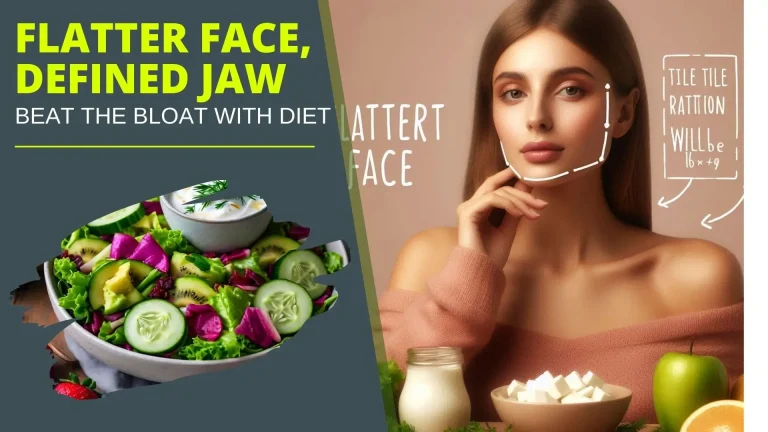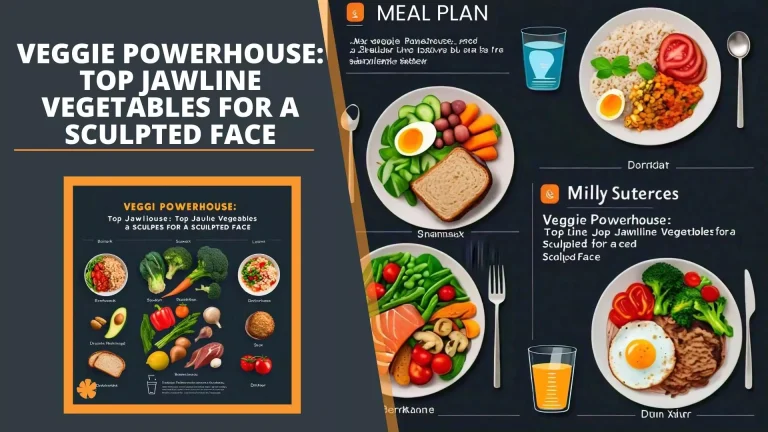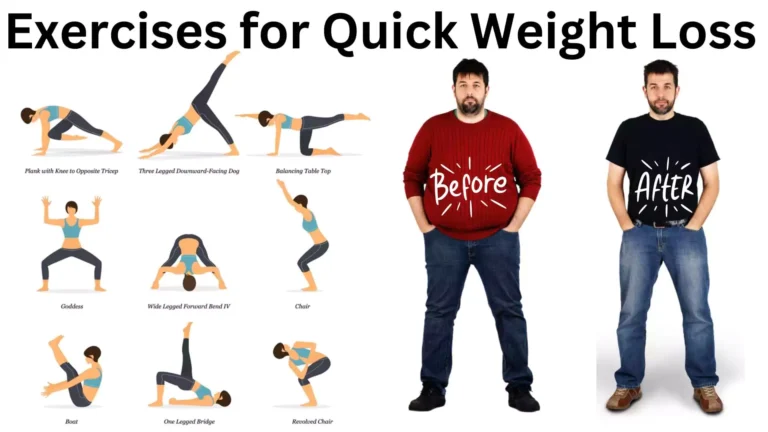Low-Sodium Secrets: The Key to a Sharper Jawline
For anyone looking to achieve a sharper, more defined jawline, reducing sodium intake is a powerful and often overlooked strategy. A high-sodium diet can cause water retention and bloating, making your face appear puffier. By embracing a low-sodium lifestyle, you not only support better health but also work towards a more sculpted, defined look. Let’s explore how a low-sodium diet can enhance your facial structure, which foods to incorporate, and practical tips for reducing sodium without sacrificing flavor.
How a Low-Sodium Diet Can Enhance Your Jawline

A low-sodium diet has benefits that extend beyond heart health; it can be a game-changer for facial definition. Sodium plays a role in regulating fluid balance, but excessive intake can lead to water retention, causing facial bloating and swelling. By cutting back on sodium, you help your body flush out excess water, leading to a slimmer, more sculpted face and a sharper jawline.
The Role of Sodium in Facial Puffiness
When sodium levels are high, the body retains water to balance out this excess, leading to a puffy or bloated appearance. This retention is particularly noticeable in delicate areas like the face, especially around the cheeks and jawline. A lower sodium intake reduces this water retention, helping to highlight natural contours and promoting a more defined facial structure.
Low-Sodium Foods for a Defined Jawline

Incorporating low-sodium foods into your diet doesn’t have to be restrictive or challenging. Here are some nutrient-rich, low-sodium foods that can help you achieve a defined jawline:
1. Leafy Greens (Spinach, Kale, Swiss Chard)
Leafy greens are packed with vitamins, minerals, and antioxidants while being naturally low in sodium. They promote overall skin health and provide essential nutrients like potassium and magnesium, which help regulate sodium levels.
Benefits:
- High in fiber, supporting digestion and fullness
- Rich in antioxidants that reduce inflammation
- Natural diuretics, helping to reduce bloating
How to Include in Your Diet:
Add them to salads, smoothies, or soups. Lightly sautéed greens are also a great low-sodium side dish.
2. Cucumbers
Cucumbers are primarily water, which makes them an excellent choice for reducing bloating. With a natural diuretic effect, they help flush out excess sodium and reduce puffiness.
Benefits:
- High water content for hydration
- Silica supports skin health and elasticity
- Great for snacking or adding to salads for a refreshing crunch
How to Include in Your Diet:
Enjoy cucumber slices as a snack, add them to salads, or use them in smoothies. Cucumber-infused water is another refreshing option.
3. Bell Peppers
Bell peppers are rich in vitamin C, which supports collagen production and helps maintain skin elasticity. They’re also low in sodium and calories, making them a great choice for a sharp jawline.
Benefits:
- High in antioxidants to fight inflammation
- Natural sweetness adds flavor without needing added salt
- Hydrating and great for snacking or adding to meals
How to Include in Your Diet:
Slice them up for a crunchy snack, add them to stir-fries, or roast them for added depth of flavor.
4. Berries
Berries like blueberries, strawberries, and raspberries are low in sodium and high in antioxidants. These fruits combat inflammation and promote a healthy complexion, giving your face a naturally toned look.
Benefits:
- Loaded with antioxidants that reduce inflammation
- Low in sodium and high in fiber
- Delicious and versatile, great for snacking or adding to smoothies
How to Include in Your Diet:
Add berries to your breakfast oatmeal, enjoy them as a snack, or blend them into a smoothie with leafy greens.
5. Bananas
Bananas are a rich source of potassium, which helps counteract the effects of sodium in the body and reduces bloating. While not low in calories, their potassium content makes them valuable for a low-sodium diet.
Benefits:
- High in potassium, which helps balance sodium levels
- Good for snacking and a natural energy booster
- Great for reducing water retention
How to Include in Your Diet:
Add banana slices to your morning cereal, blend them into smoothies, or enjoy as a pre-workout snack.
Additional Low-Sodium Tips for a Sharper Jawline

Reducing sodium intake doesn’t have to mean sacrificing flavor. Here are some practical ways to lower your sodium while still enjoying delicious meals:
1. Limit Processed Foods
Processed foods are often loaded with hidden sodium. Cutting back on pre-packaged snacks, canned soups, and processed meats can make a big difference in your daily sodium intake.
Alternative:
Choose whole, fresh foods whenever possible. Fresh fruits, vegetables, lean meats, and whole grains contain naturally low sodium levels, helping you maintain control over your sodium intake.
2. Use Herbs and Spices for Flavor
Instead of reaching for the salt shaker, enhance the taste of your food with herbs and spices. Basil, thyme, rosemary, and turmeric are great options that add flavor without sodium.
Alternative:
Experiment with spices like cumin, chili powder, or garlic powder to enhance flavors in your meals. This method not only reduces sodium but also adds antioxidants that support skin health.
3. Choose Low-Sodium Versions of Common Foods
When possible, opt for low-sodium versions of staples like broth, soy sauce, and canned goods. Many brands now offer low-sodium or reduced-sodium options.
Alternative:
Look for “no salt added” or “low-sodium” labels when grocery shopping. You can also rinse canned vegetables to reduce some of the sodium content.
4. Drink Plenty of Water
Staying hydrated is essential for flushing out excess sodium and reducing water retention. Drinking plenty of water helps balance your sodium levels and supports a clearer, more defined facial appearance.
Tip:
Add slices of cucumber, lemon, or mint to your water for a refreshing, natural way to stay hydrated and avoid bloating.
5. Practice Portion Control with High-Sodium Foods
Certain high-sodium foods are hard to avoid altogether, especially in social settings. In these cases, practice portion control to limit your intake of foods like chips, pretzels, or salted nuts.
Alternative:
When you do have high-sodium foods, balance them out with plenty of water and high-potassium foods like bananas or leafy greens to counter the effects of sodium.
Sample Low-Sodium Meal Plan for a Defined Jawline

Here’s a sample one-day meal plan that incorporates low-sodium foods to support your jawline goals:
Breakfast
- Green smoothie with spinach, banana, and a handful of berries
- A slice of whole-grain toast with avocado
Lunch
- Mixed green salad with cucumbers, bell peppers, and a light olive oil and lemon dressing
- Grilled chicken breast or tofu for protein
Snack
- Sliced bell peppers with hummus or a small handful of unsalted nuts
Dinner
- Baked salmon with steamed broccoli and sautéed leafy greens (like kale or Swiss chard)
- A side of roasted carrots and bell peppers
Final Thoughts on a Low-Sodium Jawline Diet
A low-sodium lifestyle can contribute to a healthier, more sculpted appearance by reducing bloating and emphasizing your natural facial contours. By focusing on fresh, whole foods and incorporating jawline-friendly ingredients, you’ll not only work toward a sharper jawline but also benefit from improved overall health. It’s all about making mindful choices, enhancing flavors with herbs and spices, and staying consistent in your diet.
By embracing a low-sodium diet, you unlock the secret to a defined, sculpted jawline and a more vibrant, healthier version of yourself.







